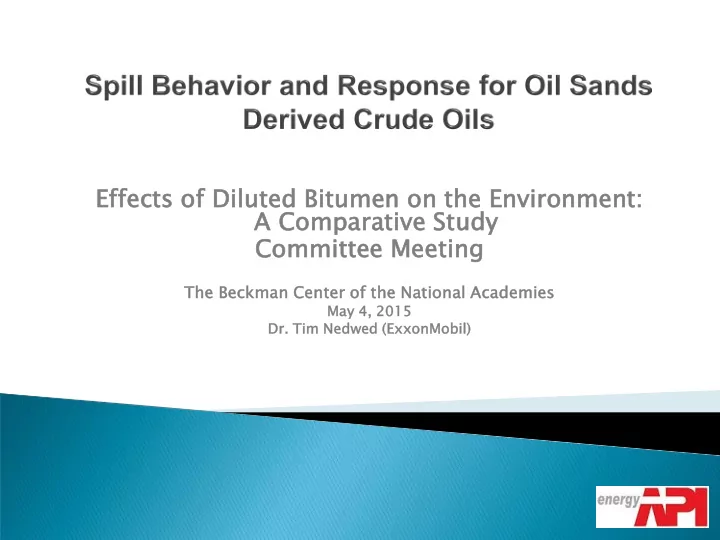

Effects ts of Dilute ted B d Bitume men o on t the E Environ ironme ment: t: A Comp ompara rative Stu Study Commi mmitte ttee M Meetin ing The Th e Beckman an C Center of the Nat atio ional A al Acad ademie ies May y 4, 2015 4, 2015 Dr. T Tim N Nedwed ( d (ExxonM nMobi bil) 1
Outline ine Background Oil sands of Alberta Oil spill prevention Oil Sands-Derived Crude Oil (OSDC) Spill Behavior API Study Comparing OSDC to Heavy Crudes Oil Spill Response Options Key to OSR for any spill including OSDC is rapid detection and response 2
Oil il Sa Sand nds of of Alb Albert rta Third largest proven petroleum reserves in the world Oil sands bitumen is biodegraded conventional crude oil Conventional crude oil migrated close to the earth’s surface allowing biodegradation that increased its viscosity and density Oil sands bitumen is treated to allow transport by pipeline to refineries Oil sands derived crudes have physical properties similar to those of traditional heavy crude oils Crude oils derived from these oil sands have been refined in North American refineries for decades Oil sands production could rise from 1.3 M barrels a day to 3.7 M to 5.4 M barrels a day over next 20 yrs Next-generation technologies improving production efficiency, reducing environmental footprint Economic and energy security benefits for both Canada and the U.S. through jobs and nearby, reliable supply 3
Oil Spill P ll Preve vention tion Along with safety, oil spill prevention will always be industry’s top priority Oil sands-derived crudes (OSDC) can be transported through the same equipment used for other crudes Unfounded speculation that oil sands products have increased likelihood of spills A National Academy of Science (2013) study showed that OSDC do not increase the risk of pipeline failures “NAS committee does not find any causes of pipeline failure unique to the transportation of diluted bitumen” “NAS committee does not find evidence of chemical or physical properties of diluted bitumen that are outside the range of other crude oils” 4
OS OSDC DC Spill ll Behavi avior or OSDC do not immediately sink in fresh/marine water All OSDC transmitted by pipeline will float when fresh Sinking can be an issue with all oil spills Sinking will depend on many variables For any spill, speed is the key to response! 5
OS OSDC DC Spill ll Behavi avior or Initial Behavior of OSDC Spills Oil sands will not separate into bitumen and diluent Spilled oil (crude or fuel) will immediately begin to weather Fuel oils may weather more slowly than OSDC Crudes may weather faster or slower OSDC tend to weather to become near the density of fresh water Densities for heavy petroleum products (such as slurry oils, No. 6 fuel oils, Bunker C) can be as low as an API gravity of 5 6
API S Study C dy Compa paring O OSDC DC to Heavy C vy Crude des API commissioned study (2012) to compare physical properties of two conventional heavy crude oils with three oil sands-derived crude oils Findings : Three OSDC tested generally evaporated more quickly than the conventional heavy crude oils All oils tested formed unstable emulsions 5 days in a circulating weathering flume No oil sank in sediment-free saltwater Two OSDC and both crude samples floated in sediment-free freshwater Only part of the third OSDC sample sank 27% in the warm fresh water 8% in the cold fresh water The viscosities of the OSDC samples increased faster and ended higher than the heavy crudes samples 7
API S Study C dy Compa paring O OSDC DC to Heavy C vy Crude des Findings: River simulating flume No difference in the behavior of the fresh un-evaporated oils ― no sinking observed Differences were noted with the evaporated oils Portion of one of the OSDC samples submerged and rolled on the bottom The other OSDC and heavy crude sample behaved similarly 8
Oil Spill R ll Respon onse Options ions Conventional response options can be used on oil sands-derived crudes (OSDC) because fresh OSDC are similar to heavy conventional crude and fuel oils Detection of Sunken Oil Sinking is not unique to OSDC Detection is a challenge A variety of techniques are available Recovery of Sunken Oil at the Bottom of a Water Body Systems are available Slow process 9
Conclu onclusion ons OSDC are heavy crude oils with physical characteristics similar to conventional heavy crude and heavy fuel oils Conventional oil spill response techniques can be used while oil is buoyant Like all oils, OSDC have the potential to become near neutrally buoyant after weathering Suspended sediment can attach to any oil and cause it settle to the bottom Sunken oil adds an additional level of complexity for response Knowledge of how any oil behaves when spilled will help in developing realistic and robust oil spill contingency plans Rapid pid re respo ponse is is crit ritic ical t l to re redu duce t the e enviro ronmental imp mpacts ts f from om any s spill, pill, and d spills pills o of oil il sands ds-der erived ed crud udes a are no no different nt 10
Subsea Dispersants – D3 11
Out utlo look for k for Ene Energ rgy Most of the world’s energy comes from hydrocarbons Global energy demand seen rising about 35 percent from 2010 to 2040 Growth in all sources of energy are needed to meet this demand Development of Alberta oil sands in a thoughtful and responsible way will ensure industry meets global energy demands now and in the future 12
Recommend
More recommend